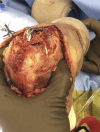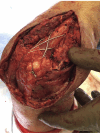Revision Olecranon Fixation: Is Tension Band Wiring the Solution? A Case Series and Review of the Literature
- PMID: 40388521
- PMCID: PMC12090888
- DOI: 10.5435/JAAOSGlobal-D-25-00049
Revision Olecranon Fixation: Is Tension Band Wiring the Solution? A Case Series and Review of the Literature
Abstract
Background: The optimal revision construct for failed olecranon fracture fixation is controversial. Here, we aim to review existing revision techniques and describe tension band wiring as a surgical option for these challenging scenarios and to evaluate its clinical and radiographic outcomes.
Methods: This retrospective case series was performed at an urban, university-based, level-1 trauma center. Patients aged 18 to 65 years who underwent revision fixation of their olecranon fracture using tension band wiring were included. The study data were collected through a retrospective chart review and review of the existing radiographic studies. Primary outcome measure was mechanical failure. Secondary outcome measures included nonunion, malunion, medical, and surgical complications. Functional outcome was determined by range of motion and restoration of extensor mechanism strength.
Results: A total of five patients were included in this study. Causes for revision were acute implant failure (n = 2), aseptic nonunion (n = 1), and infected nonunion (n = 2). All patients eventually achieved bony union after revision. Two patients required an additional surgery because of Kirschner wire migration (n = 1) and symptomatic implant (n = 1). Average flexion was 126° (range 110 to 135) and average extension was 18° (range 5 to 30). All patients experienced restoration of extensor mechanism with full strength and returned to their previous working status. No other mechanical failures, surgical complications, or medical complications occurred.
Conclusions: Early results of revision open reduction and internal fixation for failed olecranon fracture fixation using tension band wiring demonstrated favorable outcomes and low complication rates. This technique may be used for revision of failed olecranon fixation.
Copyright © 2025 The Authors. Published by Wolters Kluwer Health, Inc. on behalf of the American Academy of Orthopaedic Surgeons.
Conflict of interest statement
None of the following authors or any immediate family member has received anything of value from or has stock or stock options held in a commercial company or institution related directly or indirectly to the subject of this article: Dr. M. C. Appleton, Dr. Jakkaraju, Dr. P. C. Appleton, and Dr. Dutta.
Figures






References
-
- Tarallo L, Mugnai R, Adani R, Capra F, Zambianchi F, Catani F: Simple and comminuted displaced olecranon fractures: A clinical comparison between tension band wiring and plate fixation techniques. Arch Orthopaedic Trauma Surg 2014;134:1107-1114. - PubMed
-
- Hak DJ, Golladay GJ: Olecranon fractures: Treatment options. J Am Acad Orthopaedic Surgeons 2000;8:266-275. - PubMed
Publication types
MeSH terms
LinkOut - more resources
Full Text Sources
Medical

